| Article ID | Journal | Published Year | Pages | File Type |
|---|---|---|---|---|
| 2836341 | Physiological and Molecular Plant Pathology | 2014 | 10 Pages |
•The stimulation of defense responses was analyzed in avocado roots.•One organic extract obtained inhibited the growth of Phytophthora cinnamomi.•The inhibition appears to be due to one major compound in the extract.•The major compound decreased the ROS production of the avocado pathogen.•We suggest that the action mechanism of the compound is via ROS regulating.
The induction of defense compounds with arachidonic acid (AA) in avocado roots was analyzed in 6-month-old avocado seedlings. One organic extract was obtained 24 h after AA treatment that showed anti-oomycete activity. Two major regions of inhibition by TLC bioassay with Aspergillus were observed. One region had a high inhibitory effect on Aspergillus spore germination. This region was purified and analyzed by GC/MS spectrometry and the major compound was identified as phenol-2,4-bis (1,1-dimethylethyl) (PD). The antimicrobial activity of PD appeared to correlate with the antioxidative activity reported to this compound, because it was able to inhibit the ROS production in both Aspergillus and Phytophthora cinnamomi. This possibility was supported by an increase in the production of sporangia in Aspergillus in response to H2O2, also because the antioxidant ascorbic acid affects the Aspergillus growth concomitantly with a decrease in sporangia production. It is argued that the production of PD in avocado roots could be one of the mechanisms induced by AA that play an active role in the resistance against P. cinnamomi probably by regulating the production of H2O2.
